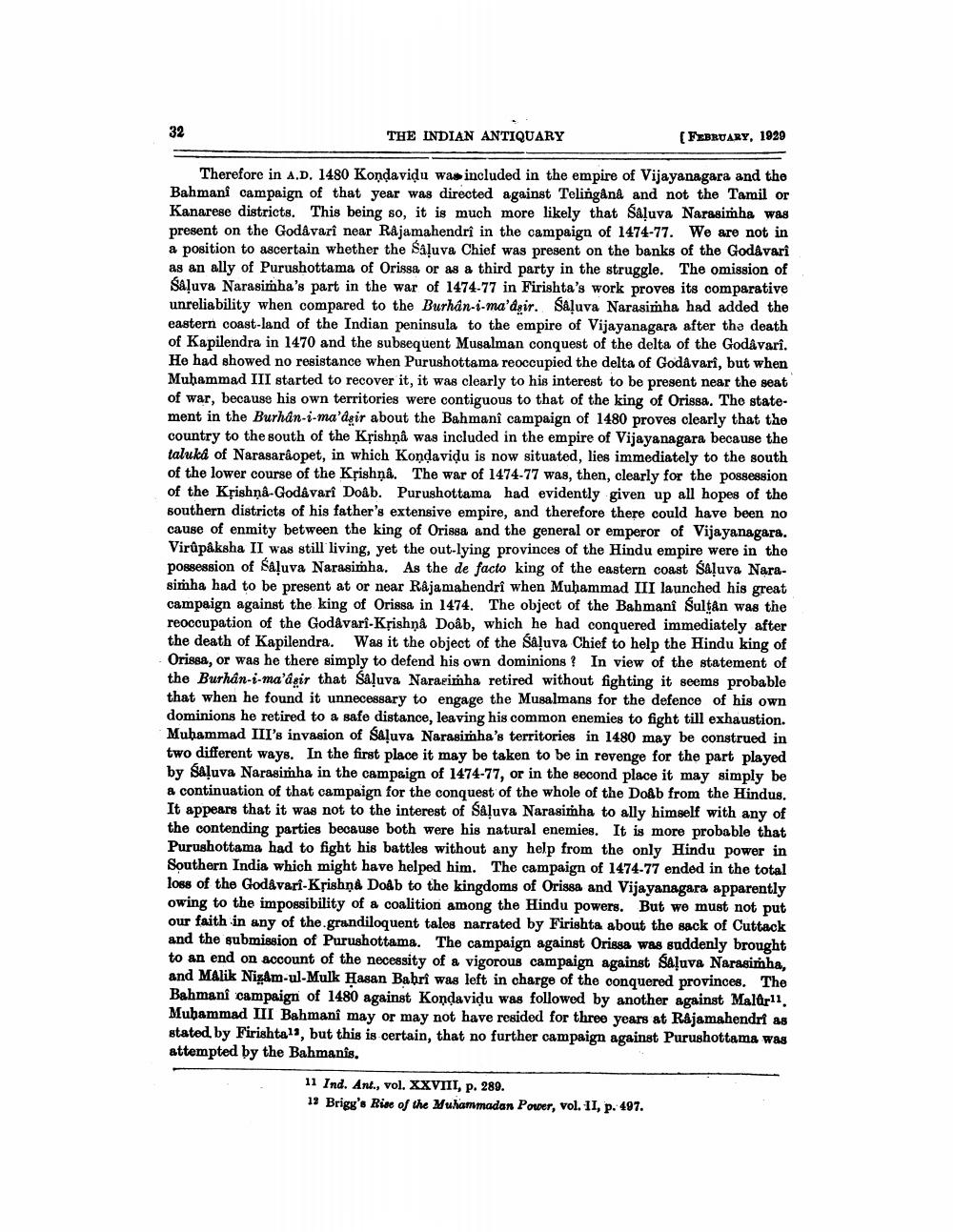________________
THE INDIAN ANTIQUARY
( FEBRUARY, 1929
Therefore in A.D. 1480 Kondavidu was included in the empire of Vijayanagara and the Bahmani campaign of that year was directed against Telingand and not the Tamil or Kanarese districts. This being so, it is much more likely that Saluva Narasimha was present on the Godavari near Rajamahendri in the campaign of 1474-77. We are not in a position to ascertain whether the Saluva Chief was present on the banks of the Godavari as an ally of Purushottama of Orissa or as a third party in the struggle. The omission of Saļuva Narasimha's part in the war of 1474-77 in Firishta's work proves its comparative unreliability when compared to the Burhan-i-ma'dsir. SAluva Narasimha had added the eastern coast-land of the Indian peninsula to the empire of Vijayanagara after the death of Kapilendra in 1470 and the subsequent Musalman conquest of the delta of the Godavari. He had showed no resistance when Purushottama reoccupied the delta of Godavari, but when Muhammad III started to recover it, it was clearly to his interest to be present near the seat of war, because his own territories were contiguous to that of the king of Orissa. The statement in the Burhan-i-ma'agir about the Bahmanî campaign of 1480 proves clearly that the country to the south of the Krishna was included in the empire of Vijayanagara because the talukd of Narasaraopet, in which Kondavidu is now situated, lies immediately to the south of the lower course of the Krishna. The war of 1474-77 was, then, clearly for the possession of the Krishna-Godavari Doâb. Purushottama had evidently given up all hopes of the southern districts of his father's extensive empire, and therefore there could have been no cause of enmity between the king of Orissa and the general or emperor of Vijayanagara. Virupaksha II was still living, yet the out-lying provinces of the Hindu empire were in the possession of Saļuva Narasimha. As the de facto king of the eastern coast Saļuva Narasimha had to be present at or near Rajamahendrî when Muhammad III launched his great campaign against the king of Orissa in 1474. The object of the Bahmani Sultan was the reoccupation of the Godavari Krishna Doab, which he had conquered immediately after the death of Kapilendra. Was it the object of the Saļuva Chief to help the Hindu king of Orissa, or was he there simply to defend his own dominions? In view of the statement of the Burhan-s-ma'asir that Saluva Narasimha retired without fighting it seems probable that when he found it unnecessary to engage the Musalmans for the defence of his own dominions he retired to a safe distance, leaving his common enemies to fight till exhaustion. Muhammad III's invasion of Saluva Narasimha's territories in 1480 may be construed in two different ways. In the first place it may be taken to be in revenge for the part played by Saļuva Narasimha in the campaign of 1474-77, or in the second place it may simply be a continuation of that campaign for the conquest of the whole of the Do&b from the Hindus. It appears that it was not to the interest of Saluva Narasimha to ally himself with any of the contending parties because both were his natural enemies. It is more probable that Purushottama had to fight his battles without any help from the only Hindu power in Southern India which might have helped him. The campaign of 1474-77 ended in the total loss of the Godavari Krishna Dodb to the kingdoms of Orissa and Vijayanagara apparently owing to the impossibility of a coalition among the Hindu powers. But we must not put our faith in any of the grandiloquent tales narrated by Firishta about the sack of Cuttack and the submission of Purushottama. The campaign against Orissa was suddenly brought to an end on account of the necessity of a vigorous campaign against Saļuva Narasimha, and Malik Nizam-ul-Mulk Hasan Babri was left in charge of the conquered provinces. The Bahmani campaign of 1480 against Kondavidu was followed by another against Maloril. Muhammad III Bahmani may or may not have resided for three years at Rajamahendri as stated, by Firishtal, but this is certain, that no further campaign against Purushottama was attempted by the Bahmanis.
11 Ind. Ant., vol. XXVIII, p. 289. 19 Brigg's Rise of the Muhammadan Power, vol. II, p. 497.




